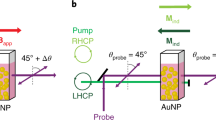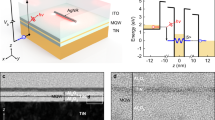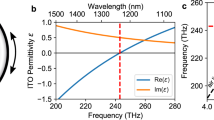Abstract
Surface-plasmon-mediated confinement of optical fields holds great promise for on-chip miniaturization of all-optical circuits1,2,3,4. Following successful demonstrations of passive nanoplasmonic devices5,6,7, active plasmonic systems have been designed to control plasmon propagation. This goal has been achieved either by coupling plasmons to optically active materials8,9,10,11,12,13 or by making use of transient optical nonlinearities in metals via strong excitation with ultrashort laser pulses14,15,16,17. Here, we present a new concept in which the active optical component is a metal–ferromagnet–metal structure. It is based on active magneto-plasmonic microinterferometry, where the surface plasmon wave vector in a gold–ferromagnet–gold trilayer system is controlled using a weak external magnetic field. Application of this new technique allows measurement of the electromagnetic field distribution inside a metal at optical frequencies and with nanometre depth resolution. Significant modulation depth combined with possible all-optical magnetization reversal induced by femtosecond light pulses18 opens a route to ultrafast magneto-plasmonic switching.
This is a preview of subscription content, access via your institution
Access options
Subscribe to this journal
Receive 12 print issues and online access
$209.00 per year
only $17.42 per issue
Buy this article
- Purchase on Springer Link
- Instant access to full article PDF
Prices may be subject to local taxes which are calculated during checkout




Similar content being viewed by others
References
Barnes, W. L., Dereux, A. & Ebbesen, T. W. Surface plasmon subwavelength optics. Nature 424, 824–830 (2003).
Genet, C. & Ebbesen, T. W. Light in tiny holes. Nature 445, 39–46 (2007).
Ozbay, E. Plasmonics: merging photonics and electronics at nanoscale dimensions. Science 311, 189–193 (2008).
Atwater, H. A. The promise of plasmonics. Sci. Am. 296, 56–63 (2008).
Altewischer, E., van Exter, M. P. & Woerdman, J. P. Plasmon-assisted transmission of entangled photons. Nature 418, 304–306 (2002).
Bozhevolnyi, S. I., Volkov, V. S., Devaux, E., Laluet, J. Y. & Ebbesen, T. W. Channel plasmon subwavelength waveguide components including interferometers and ring resonators. Nature 440, 508–511 (2006).
Kubo, A. et al. Femtosecond imaging of surface plasmon dynamics in a nanostructured silver film. Nano Lett. 5, 1123–1127 (2005).
Krasavin, A. V. & Zheludev, N. I. Active plasmonics: controlling signals in Au/Ga waveguide using nanoscale structural transformations. Appl. Phys. Lett. 84, 1416–1418 (2004).
Pacifici, D., Lezec, H. J. & Atwater, H. A. All-optical modulation by plasmonic excitation of CdSe quantum dots. Nature Photon. 1, 402–406 (2007).
Fedutik, Y., Temnov, V. V., Schöps, O., Woggon, U. & Artemyev, M. V. Exciton–plasmon–photon conversion in plasmonic nanostructures. Phys. Rev. Lett. 99, 136802 (2007).
Akimov, A. V. et al. Generation of single optical plasmons in metallic nanowires coupled to quantum dots. Nature 450, 402–406 (2007).
Dicken, M. J. et al. Electrooptic modulation in thin film barium titanate plasmonic interferometers. Nano Lett. 8, 4048–4052 (2008).
Koller, D. M. et al. Organic plasmon-emitting diode. Nature Photon. 2, 684–687 (2008).
Palomba, S. & Novotny, L. Nonlinear excitation of surface plasmon polaritons by four-wave mixing. Phys. Rev. Lett. 101, 056802 (2008).
Piredda, G., Smith, D. D., Wendling, B. & Boyd, R. W. Nonlinear optical properties of a gold–silica composite with high gold fill fraction and the sign change of its nonlinear absorption. J. Opt. Soc. Am. B 25, 945–950 (2008).
MacDonald, K. F., Samson, Z. L., Stockman, M. I. & Zheludev, N. I. Ultrafast active plasmonics. Nature Photon. 3, 55–58 (2008).
Temnov, V. V. et al. Femtosecond surface plasmon interferometry. Opt. Express 17, 8423–8432 (2009).
Stanciu, C. D. et al. All-optical magnetic recording with circularly polarized light. Phys. Rev. Lett. 99, 047601 (2007).
Wallis, R. F. Surface magnetoplasmons on semiconductors. In Boardman, A. D. (ed.) Electromagnetic Surface Modes, Ch. 15, 575–631 (John Wiley & Sons, 1982).
Gonzalez-Diaz, J. B. et al. Surface-magnetoplasmon nonreciprocity effects in noble-metal/ferromagnetic heterostructures. Phys. Rev. B 76, 153402 (2007).
Hermann, C. et al. Surface-enhanced magneto-optics in metallic multilayer films. Phys. Rev. B 64, 235422 (2001).
Gonzalez-Diaz, J. B. et al. Enhanced magneto-optics and size effects in ferromagnetic nanowire arrays. Adv. Mater. 19, 2643–2647 (2007).
Gonzalez-Diaz, J. B. et al. Plasmonic Au/Co/Au nanosandwiches with enhanced magneto-optical activity. Small 4, 202–205 (2008).
Sepulveda, B., Lechuga, L. M. & Armelles, G. Magnetooptic effects in surface-plasmon-polaritons slab waveguides. J. Lightwave Technol. 24, 945–955 (2006).
Sepulveda, B., Calle, A., Lechuga, L. & Armelles, G. Highly sensitive detection of biomolecules with the magneto-optic surface-plasmon-resonance sensor. Opt. Lett. 31, 1085–1087 (2006).
Gay, G. et al. The response of nanostructured surfaces in the near field. Nature Phys. 2, 262–267 (2006).
Temnov, V. V., Woggon, U., Dintinger, J., Devaux, E. & Ebbesen, T. W. Surface plasmon interferometry: measuring group velocity of surface plasmons. Opt. Lett. 32, 1235–1237 (2007).
Hillebrands, B. & Fassbender, J. Applied physics: ultrafast magnetic switching. Nature 418, 493–495 (2002).
Kimel, A. V. et al. Ultrafast non-thermal control of magnetization by instantaneous photomagnetic pulses. Nature 435, 655–657 (2004).
Belotelov, V. I., Doskolovich, L. L. & Zvezdin, A. K. Extraordinary magneto-optical effects and transmission through metal–dielectric plasmonic systems. Phys. Rev. Lett. 98, 077401 (2007).
Acknowledgements
This work was supported by the European Network of Excellence PhOREMOST, EU (NMP3-SL-2008-214107-Nanomagma), Spanish MICINN (‘FUNCOAT’ CONSOLIDER INGENIO 2010 CSD2008-00023 and ‘MAGPLAS’ MAT2008-06765-C02-01/NAN) CM (‘NANOMAGNET’ S-0505/MAT/0194, ‘MICROSERES’ S-0505/TIC/0191), The German Research Foundation (DFG TE770/1). We also thank J.L. Costa-Krämer for the Transverse Kerr loop measurement and K. Nelson for stimulating discussions.
Author information
Authors and Affiliations
Contributions
V.T., U.W., G.A. and A.C. wrote the proposal. V.T., U.W., G.A., A.C., A.G.M. and J.M.G.M. conceived and designed the experiments. G.A., A.C., A.G.M., J.M.G.M., T.T., A.L. and R.B. prepared and characterized the samples. A.C., D.G., A.G.M., T.T., A.L. and R.B. contributed materials and analysis tools. V.T. and G.A. performed the measurements and analysed the data. G.A., A.G.M., D.G. and V.T. carried out theoretical calculations. All authors wrote the manuscript.
Corresponding author
Ethics declarations
Competing interests
The authors declare no competing financial interests.
Supplementary information
Rights and permissions
About this article
Cite this article
Temnov, V., Armelles, G., Woggon, U. et al. Active magneto-plasmonics in hybrid metal–ferromagnet structures. Nature Photon 4, 107–111 (2010). https://doi.org/10.1038/nphoton.2009.265
Received:
Accepted:
Published:
Issue Date:
DOI: https://doi.org/10.1038/nphoton.2009.265
This article is cited by
-
Parametric study on the bimetallic cladding silica waveguide surface plasmon resonance sensor
Optical and Quantum Electronics (2023)
-
Polarization transformation and destructive interference on subwavelength magnetic domains in magneto-plasmonic systems
Scientific Reports (2022)
-
Design and Analysis of Ultra-wideband and Miniaturized Bandpass Filter Based on Spoof Surface Plasmon Polaritons
Plasmonics (2022)
-
Numerical finite-difference time-domain calculation for extreme enhancement of magneto-optical effect at ultraviolet wavelength using Ni-subwavelength grating on SiO2/Ni structure
Optical Review (2022)
-
Magnetically controllable metasurface and its application
Frontiers of Optoelectronics (2021)



